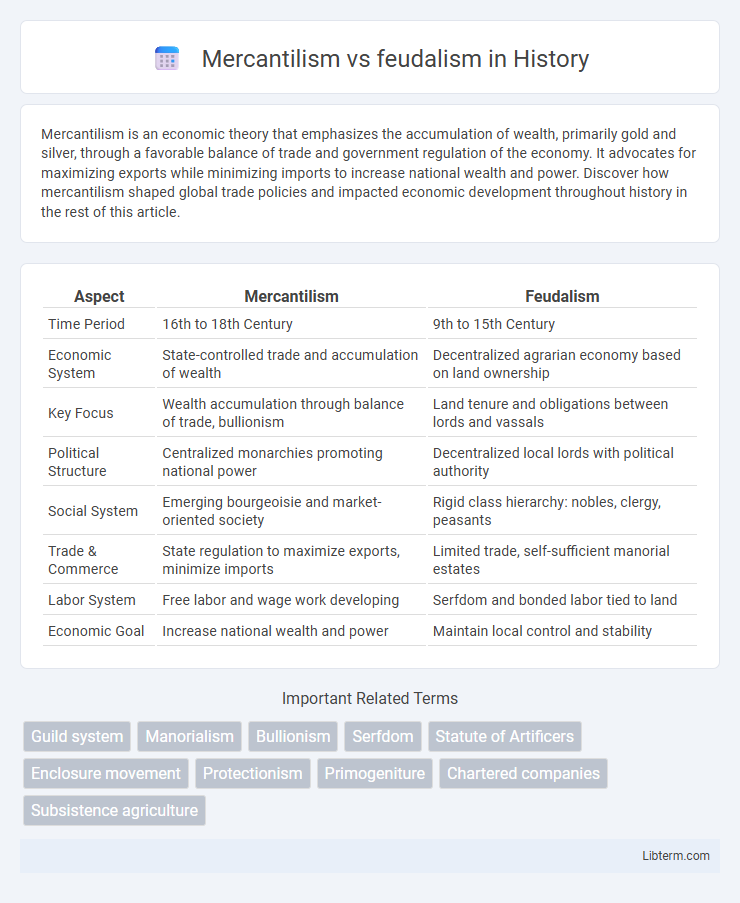Mercantilism is an economic theory that emphasizes the accumulation of wealth, primarily gold and silver, through a favorable balance of trade and government regulation of the economy. It advocates for maximizing exports while minimizing imports to increase national wealth and power. Discover how mercantilism shaped global trade policies and impacted economic development throughout history in the rest of this article.
Table of Comparison
| Aspect | Mercantilism | Feudalism |
|---|---|---|
| Time Period | 16th to 18th Century | 9th to 15th Century |
| Economic System | State-controlled trade and accumulation of wealth | Decentralized agrarian economy based on land ownership |
| Key Focus | Wealth accumulation through balance of trade, bullionism | Land tenure and obligations between lords and vassals |
| Political Structure | Centralized monarchies promoting national power | Decentralized local lords with political authority |
| Social System | Emerging bourgeoisie and market-oriented society | Rigid class hierarchy: nobles, clergy, peasants |
| Trade & Commerce | State regulation to maximize exports, minimize imports | Limited trade, self-sufficient manorial estates |
| Labor System | Free labor and wage work developing | Serfdom and bonded labor tied to land |
| Economic Goal | Increase national wealth and power | Maintain local control and stability |
Introduction to Mercantilism and Feudalism
Mercantilism, emerging in the 16th century, is an economic theory emphasizing national wealth accumulation through trade surplus, state intervention, and colonial expansion. Feudalism, dominant in medieval Europe from the 9th to 15th centuries, is a socio-economic system based on rigid hierarchies, land ownership by nobility, and obligations between lords and vassals. These systems reflect contrasting approaches to economic organization and societal structure, with mercantilism fostering centralized state power and global trade, while feudalism centers on localized agrarian economies and fealty bonds.
Historical Context and Origins
Mercantilism emerged in the 16th century during the rise of nation-states and global trade, focusing on accumulating wealth through controlled commerce and colonial expansion. Feudalism originated in medieval Europe around the 9th century, characterized by a decentralized social system based on land ownership, vassalage, and agrarian economies. The transition from feudalism to mercantilism reflects shifts in political power, economic practices, and the development of centralized states.
Core Principles of Feudalism
Feudalism is characterized by a hierarchical system based on land ownership and reciprocal obligations between lords and vassals, where protection and service were exchanged for land tenure. The core principle involved a rigid social structure with kings granting land to nobles, who in turn provided military support and governance while peasants worked the land under their control. This contrasts with mercantilism's focus on state-controlled trade and accumulation of wealth through commerce rather than land-based power dynamics.
Key Features of Mercantilism
Mercantilism emphasized accumulating wealth through a positive trade balance, government regulation of the economy, and the establishment of colonies to provide raw materials and markets for finished goods. It supported protective tariffs, subsidized industries, and monopolies granted by the state to enhance national power and economic self-sufficiency. Unlike feudalism's agrarian, hierarchical system based on land ownership and hereditary obligations, mercantilism centered on commercial expansion and centralized state control over economic activities.
Economic Structures Compared
Mercantilism centers on state-controlled trade and accumulation of wealth through a positive balance of exports, emphasizing national economic growth and centralized regulation. Feudalism relies on a decentralized agrarian economy where land ownership and vassal-lord relationships determine wealth and production, with limited market exchange. The shift from feudal agrarian economies to mercantilist trade systems marks a transformation toward early capitalist principles and global commerce expansion.
Role of Government and Authority
Mercantilism emphasizes a strong centralized government that actively controls trade, regulates the economy, and accumulates wealth through state intervention to enhance national power. Feudalism operates through a decentralized hierarchy where authority is distributed among local lords who exercise power over land and serfs, with limited direct state interference. Mercantilist governments enforce policies such as tariffs and monopolies, while feudal authorities rely on land ownership and personal loyalty to maintain control.
Social Hierarchies and Class Systems
Mercantilism established a more dynamic social hierarchy where the bourgeoisie gained economic power through trade and commerce, challenging the traditional aristocratic dominance seen in feudalism. Feudalism was characterized by rigid class systems with serfs bound to land under the control of nobles and monarchs, creating a largely static social structure. The rise of mercantilist economies contributed to the decline of feudal class rigidity by promoting social mobility based on wealth accumulation rather than hereditary status.
Trade and Commerce Dynamics
Mercantilism, emerging in the 16th century, emphasized state control over trade, promoting exports over imports to accumulate national wealth and precious metals, while feudalism relied on localized agrarian economies with minimal external trade. In mercantilist systems, centralized governments implemented tariffs, monopolies, and colonial expansion to dominate international commerce, contrasting sharply with feudalism's fragmented manorial estates where barter and subsistence agriculture prevailed. The shift from feudalism to mercantilism marked a transformation in trade dynamics, fostering urbanization, market economies, and the rise of merchant classes pivotal to early capitalist development.
Impact on Modern Economic Thought
Mercantilism's emphasis on state control, trade balance, and accumulation of wealth influenced the development of modern economic nationalism and protectionism, shaping contemporary fiscal policies and international trade strategies. Feudalism's decentralized economic structure and reliance on agrarian production contrasted with Mercantilism's market-oriented approach, highlighting the shift towards centralized economic planning and capitalist frameworks. The transition from feudal systems to mercantilist policies laid foundational ideas for economic theories concerning state intervention, wealth accumulation, and market regulation in modern economics.
Conclusion: Contrasts and Legacy
Mercantilism fostered centralized economic policies emphasizing national wealth accumulation through trade surplus, contrasting with feudalism's decentralized, agrarian-based social hierarchy. Mercantilism's legacy includes the foundation of modern capitalism and global trade networks, whereas feudalism's influence persists primarily in historical social structures and localized governance models. The transition from feudalism to mercantilism marks a pivotal shift towards modern economic systems driven by market expansion and state intervention.
Mercantilism Infographic

 libterm.com
libterm.com